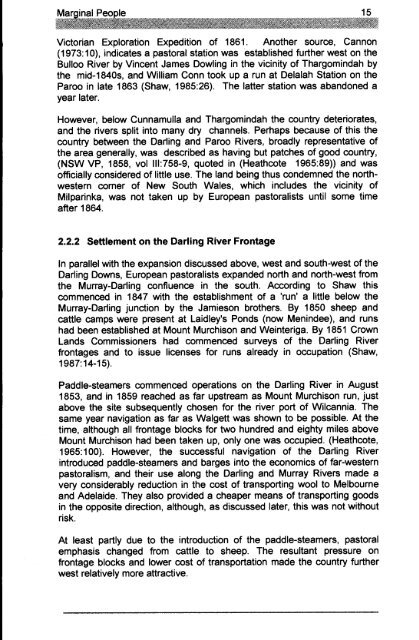Adec Preview Generated PDF File - The Sydney eScholarship ...
Adec Preview Generated PDF File - The Sydney eScholarship ...
Adec Preview Generated PDF File - The Sydney eScholarship ...
Create successful ePaper yourself
Turn your PDF publications into a flip-book with our unique Google optimized e-Paper software.
Victorian Exploration Expedition of 1861. Another source, Cannon<br />
(1973: 10), indicates a pastoral station was established further west on the<br />
Bulloo River by Vincent James Dowling in the vicinity of Thargomindah by<br />
the mid-1840s, and William Conn took up a run at Delalah Station on the<br />
Paroo in late 1863 (Shaw, 1985:26). <strong>The</strong> latter station was abandoned a<br />
year later.<br />
However, below Cunnamulla and Thargomindah the country deteriorates,<br />
and the rivers split into many dry channels. Perhaps because of this the<br />
country between the Darling and Paroo Rivers, broadly representative of<br />
the area generally, was described as having but patches of good country,<br />
(NSW VP, 1858, vol 111:758-9, quoted in (Heathcote 1965:89» and was<br />
officially considered of little use. <strong>The</strong> land being thus condemned the northwestern<br />
corner of New South Wales, which includes the vicinity of<br />
Milparinka, was not taken up by European pastoralists until some time<br />
after 1864.<br />
2.2.2 Settlement on the Darling River Frontage<br />
In parallel with the expansion discussed above, west and south-west of the<br />
Darling Downs, European pastoralists expanded north and north-west from<br />
the Murray-Darling confluence in the south. According to Shaw this<br />
commenced in 1847 with the establishment of a 'run' a little below the<br />
Murray-Darling junction by the Jamieson brothers. By 1850 sheep and<br />
cattle camps were present at Laidley's Ponds (now Menindee), and runs<br />
had been established at Mount Murchison and Weinteriga. By 1851 Crown<br />
Lands Commissioners had commenced surveys of the Darling River<br />
frontages and to issue licenses for runs already in occupation (Shaw,<br />
1987:14-15).<br />
Paddle-steamers commenced operations on the Darling River in August<br />
1853, and in 1859 reached as far upstream as Mount Murchison run, just<br />
above the site subsequently chosen for the river port of Wilcannia. <strong>The</strong><br />
same year navigation as far as Walgett was shown to be possible. At the<br />
time, although all frontage blocks for two hundred and eighty miles above<br />
Mount Murchison had been taken up, only one was occupied. (Heathcote,<br />
1965:100). However, the successful navigation of the Darting River<br />
introduced paddle-steamers and barges into the economics of far-western<br />
pastoralism, and their use along the Darling and Murray Rivers made a<br />
very considerably reduction in the cost of transporting wool to Melbourne<br />
and Adelaide. <strong>The</strong>y also provided a cheaper means of transporting goods<br />
in the opposite direction, although, as discussed later, this was not without<br />
risk.<br />
At least partly due to the introduction of the paddle-steamers, pastoral<br />
emphasis changed from cattle to sheep. <strong>The</strong> resultant pressure on<br />
frontage blocks and lower cost of transportation made the country further<br />
west relatively more attractive.




